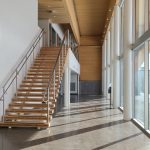
Teddy Montee Q&A: A Bold Perspective
April 10, 2025
Sustainability in Construction
April 21, 2025
Smoke ‘Em if You Got ‘Em: The Cannabis Construction Boom
What Developers Need to Know About Building Dispensaries and Grow Facilities
The cannabis industry is blazing across the nation. As legalization spreads across the U.S., dispensaries and cultivation facilities are popping up in urban centers and rural landscapes alike. But building these groundbreaking developments isn’t just another commercial project. Kiesland Development Services has experience with building projects for the cannabis industry. In this post, we reveal some of the challenges, regulations, and technical demands that developers should know about before breaking ground.
Zoning and Permitting: The First Hurdle
The cannabis market is projected to reach over $50 billion annually in the U.S. alone by 2030, and this growth fuels a steady demand for dispensaries, greenhouses, indoor grow operations, and processing facilities. But with cannabis still federally illegal, the rules governing its production and sale vary wildly by state—and sometimes even by municipality. Before the first shovel hits the ground, construction firms must wrangle with zoning and permitting, and those elements are often more restrictive than for other commercial buildings. Dispensaries are typically prohibited within a certain distance of schools, parks, or churches. Cultivation facilities may face strict limits on size, water usage, odor, and security.
Kiesland has experience with building projects for the cannabis industry. In 2018, our team delivered one of Ohio’s first cannabis cultivation facilities, Ancient Roots in Wilmington. The project involved a greenhouse, a pharmaceutical manufacturing facility for the production of products like flower, concentrates, and edibles, and back office space. Before Kiesland could put a shovel in the dirt, Ancient Roots was required to submit a proposal to the State of Ohio outlining everything the site would require. This proposal helped secure Ancient Roots’ license to grow cannabis, and then Kiesland worked with the client and state officials to ensure the project met the proposal’s expectations.
Building for Security
Security is one of the most critical components of cannabis construction. Regulatory agencies demand robust systems to prevent theft, diversion, and unauthorized access.
That typically means:
- Reinforced entry points and window glazing
- Controlled access zones
- 24/7 surveillance with high-resolution cameras
- Alarm systems with backup power
- Secure vaults or safes for product storage
Grow facilities may also require secured fencing, motion detectors, and patrol routes. In our experience, projects for the cannabis industry also require live cameras that allow state officials to monitor day-to-day activities. All security measures must comply with local codes, including additional insurance requirements or investor demands. This adds cost and complexity to the build, so contractors must factor it in from the earliest stages of design.
HVAC and Environmental Controls
Kiesland is currently in talks with developers to deliver three additional cannabis-related projects. Two opportunities involve new dispensaries in Downtown Cincinnati and Lexington, Kentucky, and the third project is a cannabis grow site in Central Kentucky. Our team understands that the initial design stages are crucial for establishing effective environmental controls and ensuring that cannabis plants can thrive in the built environment.
Early in the planning process, Kiesland works with our architect and engineering partners to outline essential climate control needs. An indoor grow facility offers greater control than a greenhouse structure, including the ability to manage consistent lighting, humidity, airflow, and temperature.
For cannabis-related construction projects, HVAC systems aren’t just about comfort—they’re mission-critical infrastructure.
Indoor grows often require:
- Specialized dehumidification systems
- High-capacity ventilation
- CO2 supplementation
- Cleanroom-style filtration to prevent pests and mildew
- Redundant systems to ensure uptime
Lighting is another major factor. Many growers use high-intensity discharge (HID) or LED grow lights that generate heat and require dedicated electrical infrastructure.
The energy demands of a single indoor grow facility can rival a data center. Construction teams must coordinate with electrical engineers and utility providers early on to ensure that systems are scalable and sustainable.
Aesthetic and Customer Experience
For dispensaries, design matters. Today’s cannabis retailers aren’t headshops with tie-die t-shirts and a variety of artful glass pipes for sale. They’re premium retail spaces that look more like a jeweler or a place to buy the latest smartphone, often targeting upscale consumers. It’s an aesthetic that includes sleek finishes, welcoming lobbies, smart lighting, and seamless security integration.
But even though dispensaries are construction projects for retail and medical cannabis sales, they must still comply with laws for product display and access, including:
- No self-serve areas
- Product locked behind counters or in display cases
- Limited signage and advertising
Construction firms need to work with architects who understand both branding and compliance. For every cannabis-related construction project, Kiesland is focused on delivering a project that feels modern and professional—without violating regulations.
Final Thoughts
The cannabis industry offers real opportunities for commercial real estate developers willing to adapt. But this isn’t a plug-and-play sector. Every project demands an expert construction partner with a deep understanding of local laws, industry standards, and specialized infrastructure needs.
Kiesland Development Services is pleased to be a trusted construction partner in one of the world’s fastest-growing industries.
